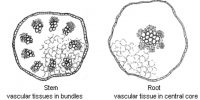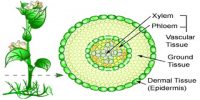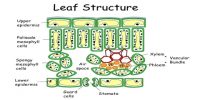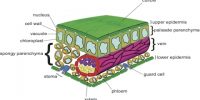Dicot root has a tap root-like arrangement and is present in dicot plants. It has a constant amount of xylem and phloem such that, xylem is in ‘X’ form and is bounded by phloem. Dicot root shows secondary growth. Pea, beans, and peanuts, etc. are examples of dicot roots.
Monocot root has fibrous root-like formation and is present in monocot plants. It has xylem and phloem in sporadic manners set in a ring-like formation. There is no secondary growth in monocot roots. Maize, banana, and palm, etc. are its examples.
Comparison between the Dicot Root and Monocot Root
Dicot Root – The root of the plant that has two cotyledons in its seed is known as dicot root.
- Vascular bundles are open and Diarch to hexarch.
- Pith: Pith generally small or absent.
- Structure: It is narrow and has a tap root-like structure.
- In Cambium form, conjunctive tissue becomes meristematic and results in secondary growth
- Pericycle: The pericycle gives rise to lateral roots, cork cambium, and the part of the vascular cambium. Pericycle may give rise to cork cambium and lateral branches. It gives rise to cork cambium, lateral roots and parts of the vascular cambium.
- Xylem & Phloem: The xylem and phloem are limited in numbers.
- Secondary Growth: The secondary growth occurs in the dicot root.
- Connective Tissues: In dicot roots, there are parenchymatous connective tissues.
- Cambium: This root has cambium which is formed by the conjunctive parenchyma.
- Cortex: Cortex is narrow in dicot roots.
- Covering: In this root, older roots are covered by cork.
- Examples: Beans, pea, and peanuts, etc. have dicot roots.
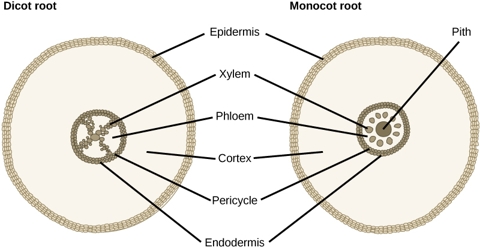
Monocot Root – The root of the plant that has single cotyledon in its seed is known as monocot root.
- Vascular bundles are polyarch closed
- Pith: Pith is large and well developed.
- Structure: It is comparatively wider and has fibrous root-like structure.
- In Cambium form, conjunctive tissue does not become a meristem and complete absence of secondary growth.
- Pericycle: The pericycle present only produces the lateral roots. Pericycle may give rise to only lateral branches. Pericycle forms lateral roots only.
- Xylem & Phloem: The xylem and phloem are numerous in numbers.
- Secondary Growth: The secondary growth absents in the monocot root.
- Connective Tissues: Monocot roots have sclerenchymatous connective tissues.
- Cambium: In these roots, cambium is absent.
- Cortex: Cortex is very wide in monocot roots.
- Covering: In this root, older roots are covered by exodermis
- Examples: Banana, maize, and palm, etc. are examples of monocot roots.

